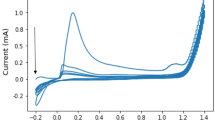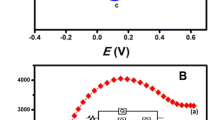Abstract
This paper discusses the development of a glassy carbon electrode (GC) for the determination and electro-remediation of sulfamethazine (SMZ) in natural waters using multi-walled carbon nanotubes (MWCNT) and silver nanoparticles (AgNPs) as electrode modifiers. The SMZ is an antibiotic found in surface and groundwater that can cause impacts for the environment and the population even at low concentrations. Therefore, it is essential to develop innovative approaches for the SMZ determination and degradation. The proposed GC electrode modifier was characterized demonstrating that the silver nanoparticles was incorporated onto the MWCNT. Voltammetric parameters of the SMZ oxidation process were optimized to improve the response in the analysis. The linearity obtained was from 0.3 to 5.0 µmol L−1, and the limit of detection and limit of quantification obtained was 0.19 µmol L−1 and 0.63 µmol L−1, respectively. This electrode was used for SMZ quantification in natural waters and interferents were used in a selectivity study. Finally, the GC/MWCNT-AgNPs was applied for the remediation of SMZ using chronoamperometry with +1.5 V for 2.5 h, decreasing 62.04% of the antibiotic. As a result, MWCNT-AgNPs were found to be an excellent option for the effective determination and remediation of the SMZ.







Similar content being viewed by others
References
Deng R, Luo H, Huang D, Zhang C (2020) Biochar-mediated fenton-like reaction for the degradation of sulfamethazine: role of environmentally persistent free radicals. Chemosphere 255:126975. https://doi.org/10.1016/j.chemosphere.2020.126975
Yin R, Guo W, Wang H, Du J, Zhou X, Wu Q, Zheng H, Chang J, Ren N (2018) Enhanced peroxymonosulfate activation for sulfamethazine degradation by ultrasound irradiation: performances and mechanisms. Chem Eng J 335:145–153. https://doi.org/10.1016/j.cej.2017.10.063
Urzúa L, Pérez-Ortiz M, Álvarez-Lueje A, Urzúa L, Pérez-Ortiz M, Álvarez-Lueje A (2018) Electrocatalytic oxidation and voltammetric determination of sulfamethazine using a modified carbon electrode with ionic liquid. J Chil Chem Soc 63:3914–3917. https://doi.org/10.4067/s0717-97072018000103914
Lin C-C, Huang C-Y (2024) Degradation of sulfamethazine in water in thermally activated persulfate process. J Taiwan Inst Chem Eng 155:105229. https://doi.org/10.1016/j.jtice.2023.105229
Chen J, Zhou X, Zhang Y, Gao H (2012) Potential toxicity of sulfanilamide antibiotic: binding of sulfamethazine to human serum albumin. Sci Total Environ 432:269–274. https://doi.org/10.1016/j.scitotenv.2012.06.003
Carstens KL, Gross AD, Moorman TB, Coats JR (2013) Sorption and photodegradation processes govern distribution and fate of sulfamethazine in freshwater-sediment microcosms. Environ Sci Technol 47:10877–10883. https://doi.org/10.1021/es402100g
Silva M, Cesarino I (2019) Evaluation of a nanocomposite based on reduced graphene oxide and gold nanoparticles as an electrochemical platform for detection of sulfamethazine. J Compos Sci 3:59. https://doi.org/10.3390/jcs3020059
Mulla SI, Bagewadi ZK, Faniband B, Bilal M, Chae J-C, Bankole PO, Saratale GD, Bhargava RN, Gurumurthy DM (2023) Various strategies applied for the removal of emerging micropollutant sulfamethazine: a systematic review. Environ Sci Pollut Res 30:71599–71613. https://doi.org/10.1007/s11356-021-14259-w
Mo H, Li X, Zhou X, Jia X, Wang H, Xu Z, Wei X (2023) Preparation of bifunctional monomer molecularly imprinted polymer filled solid-phase extraction for sensitivity improvement of quantitative analysis of sulfonamide in milk. J Chromatogr A 1700:464046. https://doi.org/10.1016/j.chroma.2023.464046
Zhang Y, Liu G, Xue Y, Fu L, Qian Y, Hou M, Li X, Ling C, Zhang Y, Pan Y (2024) Boron promoted Fe3+/peracetic acid process for sulfamethazine degradation: efficiency, role of boron, and identification of the reactive species. J Environ Sci 135:72–85. https://doi.org/10.1016/j.jes.2022.12.024
Chen J, Ke Y, Zhu Y, Chen X, Xie S (2023) Deciphering of sulfonamide biodegradation mechanism in wetland sediments: from microbial community and individual populations to pathway and functional genes. Water Res 240:120132. https://doi.org/10.1016/j.watres.2023.120132
He T, Xu Z, Ren J (2019) Pressure-assisted electrokinetic injection stacking for seven typical antibiotics in waters to achieve Μg/L level analysis by capillary electrophoresis with UV detection. Microchem J 146:1295–1300. https://doi.org/10.1016/j.microc.2019.02.057
Yang M, Wu X, Hu X, Wang K, Zhang C, Gyimah E, Yakubu S, Zhang Z (2019) Electrochemical immunosensor based on Ag+-dependent CTAB-AuNPs for ultrasensitive detection of sulfamethazine. Biosens Bioelectron 144:111643. https://doi.org/10.1016/j.bios.2019.111643
Govindaraj M, Rajendran JPKUG, Muthukumaran MK, Jayaraman BJAS (2023) Graphitic carbon nitride nanosheets decorated with strontium tungstate nanospheres as an electrochemical transducer for sulfamethazine sensing. ACS Appl Nano Mater 6:930–945. https://doi.org/10.1021/acsanm.2c04322
Nehru R, Chen C-W, Dong C-D (2023) Sonochemically synthesized rod-like bismuth phosphate and carbon black hybrid electrocatalyst for electrochemical monitoring of hazardous sulfamethazine. J Environ Chem Eng 11:109420. https://doi.org/10.1016/j.jece.2023.109420
Cesarino I, Simões RP, Lavarda FC, Batagin-Neto A (2016) Electrochemical oxidation of sulfamethazine on a glassy carbon electrode modified with graphene and gold nanoparticles. Electrochim Acta 192:8–14. https://doi.org/10.1016/j.electacta.2016.01.178
Bagyalakshmi S, Sivakami A, Pal K, Sarankumar R, Mahendran C (2022) Manufacturing of electrochemical sensors via carbon nanomaterials novel applications: a systematic review. J Nanopart Res 24:201. https://doi.org/10.1007/s11051-022-05576-3
Barsan MM, Ghica ME, Brett CMA (2015) Electrochemical sensors and biosensors based on redox polymer/carbon nanotube modified electrodes: a review. Anal Chim Acta 881:1–23. https://doi.org/10.1016/j.aca.2015.02.059
Jacobs CB, Peairs MJ, Venton BJ (2010) Review: carbon nanotube based electrochemical sensors for biomolecules. Anal Chim Acta 662:105–127. https://doi.org/10.1016/j.aca.2010.01.009
Ferrier DC, Honeychurch KC (2021) Carbon nanotube (CNT)-based biosensors. Biosensors 11:486. https://doi.org/10.3390/bios11120486
Barreto FC, Silva MKL, Cesarino I (2022) An electrochemical sensor based on reduced graphene oxide and copper nanoparticles for monitoring estriol levels in water samples after bioremediation. Chemosensors 10:395. https://doi.org/10.3390/chemosensors10100395
Rassaei L, Marken F, Sillanpää M, Amiri M, Cirtiu CM, Sillanpää M (2011) Nanoparticles in electrochemical sensors for environmental monitoring. TrAC, Trends Anal Chem 30:1704–1715. https://doi.org/10.1016/j.trac.2011.05.009
Barreto FC, Ito EY, Mounienguet NK, Dal’ Evedove Soares L, Yang J, He QS, Cesarino I (2023) Electrochemical sensor based on spent coffee grounds hydrochar and metal nanoparticles for simultaneous detection of emerging contaminants in natural water. Chemosensors 11:562. https://doi.org/10.3390/chemosensors11110562
Ivanišević I (2023) The role of silver nanoparticles in electrochemical sensors for aquatic environmental analysis. Sensors 23:3692. https://doi.org/10.3390/s23073692
Yogeswaran U, Thiagarajan S, Chen S-M (2008) Recent updates of DNA Incorporated in carbon nanotubes and nanoparticles for electrochemical sensors and biosensors. Sensors 8:7191–7212. https://doi.org/10.3390/s8117191
Gao M, Qi H, Gao Q, Zhang C (2008) Electrochemical detection of DNA hybridization based on the probe labeled with carbon-nanotubes loaded with silver nanoparticles. Electroanalysis 20:123–130. https://doi.org/10.1002/elan.200703998
Cesarino I, Cesarino V, Moraes FC, Ferreira TCR, Lanza MRV, Mascaro LH, Machado SAS (2013) Electrochemical degradation of benzene in natural water using silver nanoparticle-decorated carbon nanotubes. Mater Chem Phys 141:304–309. https://doi.org/10.1016/j.matchemphys.2013.05.015
Han E, Li L, Gao T, Pan Y, Cai J (2024) Nitrite determination in food using electrochemical sensor based on self-assembled MWCNTs/AuNPs/poly-melamine nanocomposite. Food Chem 437:137773. https://doi.org/10.1016/j.foodchem.2023.137773
Anshori I, Ula LR, Asih GIN, Ariasena E, Uperianti RAN, Mulyaningsih Y, Handayani M, Purwidyantri A, Prabowo BA (2023) Durable nonenzymatic electrochemical sensing using silver decorated multi-walled carbon nanotubes for uric acid detection. Nanotechnology 35:115501. https://doi.org/10.1088/1361-6528/ad143f
Donini CA, da Silva MKL, Simões RP, Cesarino I (2018) Reduced graphene oxide modified with silver nanoparticles for the electrochemical detection of estriol. J Electroanal Chem 809:67–73. https://doi.org/10.1016/j.jelechem.2017.12.054
Cesarino I, Moraes FC, Lanza MRV, Machado SAS (2012) Electrochemical detection of carbamate pesticides in fruit and vegetables with a biosensor based on acetylcholinesterase immobilised on a composite of polyaniline-carbon nanotubes. Food Chem 135:873–879. https://doi.org/10.1016/j.foodchem.2012.04.147
Bahar N, Ekinci D (2024) Dual capacitive behavior of hollow porous gold nanoparticle/multi-walled carbon nanotube composite films as anode and cathode electrode materials for supercapacitors. J Electron Mater 53:1476–1486. https://doi.org/10.1007/s11664-023-10874-0
Ma J, Zhang C, Hong X, Liu J (2023) Incorporating cerium vanadate into multi-walled carbon nanotubes for fabrication of sensitive electrochemical sensors toward sulfamethazine determination in water samples. Chemosensors 11:64. https://doi.org/10.3390/chemosensors11010064
Barreto FC, da Silva MKL, Cesarino I (2023) Copper nanoparticles and reduced graphene oxide as an electrode modifier for the development of an electrochemical sensing platform for chloroquine phosphate determination. Nanomaterials 13:1436. https://doi.org/10.3390/nano13091436
Melaré AG, Barreto FC, Silva MKL, Simões RP, Cesarino I (2023) Determination of fluoxetine in weight loss herbal medicine using an electrochemical sensor based on rGO-CuNPs. Molecules 28:6361. https://doi.org/10.3390/molecules28176361
Gomes GC, da Silva MKL, Barreto FC, Cesarino I (2023) Electrochemical sensing platform based on renewable carbon modified with antimony nanoparticles for methylparaben detection in personal care products. Chemosensors 11:141. https://doi.org/10.3390/chemosensors11020141
Fotouhi L, Zabeti M (2014) Electrochemical oxidation of sulfamethazine on multi-walled nanotube film coated glassy carbon electrode. J Nanostruct 4:161–166. https://doi.org/10.7508/jns.2014.02.005
Guzmán-Vázquez de Prada A, Martínez-Ruiz P, Reviejo AJ, Pingarrón JM (2005) Solid-phase molecularly imprinted on-line preconcentration and voltammetric determination of sulfamethazine in milk. Analytica Chimica Acta 539:125–132. https://doi.org/10.1016/j.aca.2005.02.068
Feizollahi A, Rafati AA, Assari P, Joghani RA (2021) Development of an electrochemical sensor for the determination of antibiotic sulfamethazine in cow milk using graphene oxide decorated with Cu–Ag core-shell nanoparticles. Anal Methods 13:910–917. https://doi.org/10.1039/D0AY02261F
Cui Y-H, Chen Q, Feng J-Y, Liu Z-Q (2014) Effectiveness of electrochemical degradation of sulfamethazine on a nanocomposite sno2 electrode. RSC Adv 4:30471–30479. https://doi.org/10.1039/C4RA04244A
Fabiańska A, Białk-Bielińska A, Stepnowski P, Stolte S, Siedlecka EM (2014) Electrochemical degradation of sulfonamides at BDD electrode: kinetics, reaction pathway and eco-toxicity evaluation. J Hazard Mater 280:579–587. https://doi.org/10.1016/j.jhazmat.2014.08.050
Yu N, Lu X, Song F, Yao Y, Han E (2021) Electrocatalytic degradation of sulfamethazine on IrO2-RuO2 composite electrodes: influencing factors, kinetics and modeling. J Environ Chem Eng 9:105301. https://doi.org/10.1016/j.jece.2021.105301
Liu Y-H, Peng X-Q, Chou W-L (2020) Degradation of sulfamethazine by cerium mediated photoelectrochemical oxidation with hydroxyl radical oxidation effect. Sep Purif Technol 248:116929. https://doi.org/10.1016/j.seppur.2020.116929
Chen C, Liu L, Li Y, Li W, Zhou L, Lan Y, Li Y (2020) Insight into heterogeneous catalytic degradation of sulfamethazine by peroxymonosulfate activated with CuCo2O4 derived from bimetallic oxalate. Chem Eng J 384:123257. https://doi.org/10.1016/j.cej.2019.123257
Su P, Fu W, Du X, Guo J, Zhou M (2023) Cost-effective degradation of pollutants by in-situ electrocatalytic process on Fe@BN-C bifunctional cathode: formation of 1o2 with high selectivity under nanoconfinement. Chem Eng J 452:139693. https://doi.org/10.1016/j.cej.2022.139693
Yang Q, Liu Y, Ke J, Li C, Ge Y, Chen J, Guo R (2022) Enhanced degradation of sulfamethazine in boron-doped diamond anode system via utilization of by-product oxygen and pyrite: mechanism and pharmaceutical activity removal Assessment. Sep Purif Technol 303:122323. https://doi.org/10.1016/j.seppur.2022.122323
Ge Y, Ke J, Li X, Wang J, Yang Q, Liu Y, Guo R, Chen J (2022) Electro-activating persulfate via biochar catalytic cathode for sulfamethazine degradation: performance and mechanism insight. J Environ Chem Eng 10:109020. https://doi.org/10.1016/j.jece.2022.109020
Funding
This research received funding from Fapesp (processes 2022/03334-6 and 2022/03762-8) and Capes-PrInt (process 88881.702907/2022-01).
Author information
Authors and Affiliations
Corresponding author
Additional information
Publisher's Note
Springer Nature remains neutral with regard to jurisdictional claims in published maps and institutional affiliations.
Rights and permissions
Springer Nature or its licensor (e.g. a society or other partner) holds exclusive rights to this article under a publishing agreement with the author(s) or other rightsholder(s); author self-archiving of the accepted manuscript version of this article is solely governed by the terms of such publishing agreement and applicable law.
About this article
Cite this article
Barreto, F.C., dos Santos, G.T.V., Leao, A.L. et al. Determination and electro-remediation of sulfamethazine using carbon nanotubes and silver nanoparticles as electrode modifiers. J Solid State Electrochem (2024). https://doi.org/10.1007/s10008-024-05931-5
Received:
Revised:
Accepted:
Published:
DOI: https://doi.org/10.1007/s10008-024-05931-5




